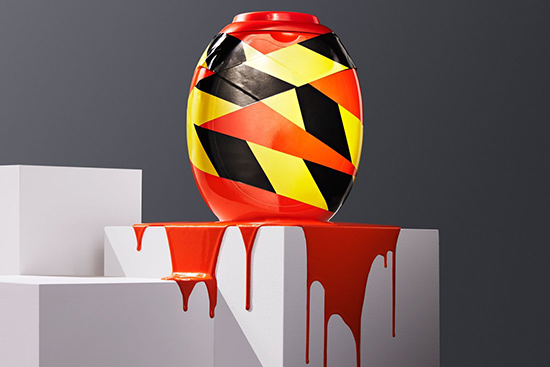這款洗衣神器竟然能殺人,該怎么破,?
|
在著名消費(fèi)品巨頭寶潔的181年歷史上,,汰漬洗衣凝珠堪稱最成功的創(chuàng)新之一,。洗衣凝珠幾乎一夜之間爆紅,,變成家用產(chǎn)品里最暢銷的品牌,。八年前,,美國(guó)商店里還幾乎沒(méi)有小包裝的液體洗衣液;2018年已經(jīng)占領(lǐng)近五分之一洗衣用品市場(chǎng),,銷售額達(dá)15億美元,。另外,寶潔旗下的汰漬凝珠和另一個(gè)流行品牌Gain Flings占據(jù)了79%的市場(chǎng)份額,。 但推動(dòng)洗衣凝珠成功的設(shè)計(jì)因素,,非常緊湊、拿取方便,,以及非常漂亮的外觀也有潛在的致命缺陷,。目前來(lái)看,幼兒和老年癡呆癥患者常常誤認(rèn)為是糖果,,有可能吃下去,。一旦出現(xiàn)這種情況,洗衣凝珠造成的后果比其他清潔劑和家用清潔產(chǎn)品更嚴(yán)重,。 2012年洗衣凝珠在北美上市后,,對(duì)公共安全的威脅立即出現(xiàn)。2011年至2013年期間,,每年急診科里兒童因洗衣液受傷就診次數(shù)增加了兩倍多,,從2862次增至9004次。 大多數(shù)損傷可以在24小時(shí)內(nèi)消除,,無(wú)長(zhǎng)期影響,。但美國(guó)毒物控制中心協(xié)會(huì)(AAPCC)的數(shù)據(jù)顯示,洗衣凝珠雖然市場(chǎng)份額僅占16%,,卻占與洗衣用品相關(guān)嚴(yán)重傷害的80%,。遇上貝拉一樣的嚴(yán)重案例,可能出現(xiàn)長(zhǎng)期并發(fā)癥,。美國(guó)與洗衣凝珠直接相關(guān)的死亡案例已達(dá)9起,,其中包括兩名2歲以下兒童和七名老年癡呆癥患者。 至于已知危險(xiǎn)的消費(fèi)者中毒案例,,大多要怪愚蠢的互聯(lián)網(wǎng)挑戰(zhàn),。2017年年底,一些青少年開(kāi)始在網(wǎng)上發(fā)布吃洗衣凝珠的視頻,,后來(lái)發(fā)展成離奇的病毒傳播現(xiàn)象,,叫做“汰漬凝珠挑戰(zhàn)”。該事件中洗衣凝珠中毒屬于自我傷害,只影響到不負(fù)責(zé)任的人,。不過(guò)凝珠挑戰(zhàn)導(dǎo)致的中毒案例只占總數(shù)的一小部分,。 面臨激增的中毒數(shù)字,還有來(lái)自于監(jiān)管機(jī)構(gòu)的壓力,,寶潔和其他凝珠制造商都嚇了一跳,,于是重新討論產(chǎn)品的設(shè)計(jì)。盡管凝珠的設(shè)計(jì)和外部包裝多次變化,,圍繞安全問(wèn)題密集召開(kāi)了行業(yè)會(huì)議,,也經(jīng)過(guò)了七年頭腦風(fēng)暴和測(cè)試,但從毒物控制中心收到的呼叫數(shù)和急診室病例來(lái)看,,情況并沒(méi)有實(shí)質(zhì)性改善,。 2013年以來(lái),每年因洗衣凝珠打電話給毒物中心求助的電話里有平均有11568次涉及幼兒,,2013年是這種產(chǎn)品在美國(guó)市場(chǎng)上市的第一個(gè)整年,。(大多數(shù)涉及洗衣凝珠的電話求助或中毒案例并未造成嚴(yán)重傷害,不過(guò)可以借此估算受影響的人群,,判斷洗衣凝珠對(duì)公共衛(wèi)生的影響,。) 造成傷害時(shí),嚴(yán)重程度也各不相同,。有數(shù)據(jù)記錄的最近一年2017年里,,35%的凝珠傷害病例最終去醫(yī)院接受治療。如果排除凝珠,,洗衣劑和家庭清潔劑導(dǎo)致前往醫(yī)院就醫(yī)的比例為16%,。 |
Tide Pods are arguably one of the most successful innovations in the storied, 181-year history of ?consumer goods leviathan Procter & Gamble. They’re also the top-selling brand in a household-product category that became ubiquitous practically overnight. Eight years ago, liquid-detergent packets were barely a presence in U.S. stores; by 2018 they accounted for nearly one-fifth of the laundry detergent market and $1.5 billion in sales. And P&G, the maker of Tide Pods and another popular brand, Gain Flings, controls 79% of that business. But the design factors that have made laundry pods so successful—their compactness, easy accessibility, and aesthetically pleasing look—are also potentially fatal flaws. Too often, it appears, young children and seniors with dementia mistake them for candy and try to eat them. And when that happens, they’re more likely than other detergents and other household cleaning products to cause serious injury. Laundry pods’ threat to public safety became apparent immediately after their North America launch in 2012. Between 2011 and 2013, the number of annual emergency-department visits for all laundry detergent-related injuries for young children more than tripled, from 2,862 to 9,004. The majority of injuries resolve within 24 hours without long-lasting effects. Still, pods make up 80% of all major injuries related to laundry detergent, according to the American Association for Poison Control Centers (AAPCC), despite accounting for only 16% of the market. In rare cases like Bella’s, long-term complications can ensue. And nine people have died in the U.S.—two children younger than age 2 and seven seniors with dementia—in cases definitively linked to laundry pods. To the extent that most consumers are aware of these dangers, it’s thanks to an asinine Internet trend. In late 2017 a handful of teenagers started posting videos online of themselves eating laundry packets in a surreal viral phenomenon known as the Tide Pod Challenge. That cultural episode cast laundry-pod poisoning as a self-inflicted wound, harming only the irresponsible. But the Challenge has accounted for only a tiny fraction of the injuries caused by this now pervasive product. P&G and other detergent makers, startled by soaring numbers and prodded by regulators, have taken the product back to the drawing board more than once. But despite multiple changes to the pods’ design and exterior packaging, intensive industrywide meetings on the issue, and seven years of brainstorming and testing, the situation has not substantially improved when measured by the total number of calls to poison-control centers and emergency-department visits. Pods have prompted an average of 11,568 poison-control calls a year involving young children since 2013, their first full year on the U.S. market. (The majority of calls, or exposures, involving pods are not associated with serious injuries, but they’re the best ?population-wide data available to measure pods’ impact on public health.) And when injuries are inflicted, they remain disproportionately severe: In 2017, the most recent year for which figures are available, 35% of pod exposure cases among the whole population wound up being treated in health care facilities; for all other laundry detergents and for household cleaning substances, that figure was 16% when pods were excluded. |

|
消費(fèi)者權(quán)益倡導(dǎo)者和公共衛(wèi)生專家認(rèn)為,盡管行業(yè)做了很多善意努力,,還是拒絕直面房間里的大象(意思是一些非常顯而易見(jiàn),,卻一直被忽略的問(wèn)題——譯者注),這次還是顏色鮮艷的彩色大象,,洗衣液的小包裝上有多彩漩渦裝飾,,看起來(lái)太像糖果。美國(guó)兒童醫(yī)院傷害研究和政策中心主任加里·史密斯表示,,如果制造商能把洗衣凝珠設(shè)計(jì)得更中性,,沒(méi)那么誘人,“就可以通過(guò)設(shè)計(jì)解決問(wèn)題,?!? 寶潔和其他洗衣用品生產(chǎn)商指出,,目前已經(jīng)應(yīng)用各種防止傷害措施,而且認(rèn)為即便不采取相關(guān)措施也降低了傷害幾率,,因?yàn)橐呀?jīng)改善包裝降低兒童誤食幾率,,也在不斷教育公眾培養(yǎng)正確的使用習(xí)慣。 “我們的工作是完全防止兒童接觸到產(chǎn)品,。” 寶潔負(fù)責(zé)全球傳播和推廣的副總裁達(dá)蒙·瓊斯表示,。 雖然并未排除進(jìn)一步改進(jìn)的可能,,但行業(yè)和監(jiān)管機(jī)構(gòu)已經(jīng)宣布暫無(wú)計(jì)劃更積極地介入安全預(yù)防。但在當(dāng)今時(shí)代,,許多面向消費(fèi)者的企業(yè)都有空間實(shí)施自我管理,,汰漬洗衣凝珠引發(fā)的困境提出了緊急且令人不安的問(wèn)題。寶潔到底有沒(méi)有盡全力確保暢銷產(chǎn)品的安全,?由于沒(méi)有法律規(guī)定限制洗衣凝珠的安全性,,能否根據(jù)倫理要求行業(yè)進(jìn)一步自律?如果一款“已改進(jìn)”的產(chǎn)品每年仍會(huì)導(dǎo)致數(shù)千次入院醫(yī)治,,能不能算安全,?制造商對(duì)事故的責(zé)任到哪個(gè)點(diǎn)終止,又從哪一點(diǎn)開(kāi)始應(yīng)該由消費(fèi)者負(fù)責(zé)任,? 種種問(wèn)題證明了美國(guó)消費(fèi)品生態(tài)系統(tǒng)里一個(gè)基本事實(shí):如何應(yīng)對(duì)消費(fèi)者風(fēng)險(xiǎn)在很大程度上取決于企業(yè),。雖然政府機(jī)構(gòu)偶爾會(huì)介入,但安全決策通常由企業(yè)領(lǐng)導(dǎo)者制定,,企業(yè)往往會(huì)在產(chǎn)品成功與聲譽(yù)和法律問(wèn)題之間尋求平衡,。至少目前寶潔已經(jīng)下了判斷,汰漬洗衣凝珠安全沒(méi)問(wèn)題,。 |
Consumer advocates and public health experts argue that, for all its well-intentioned efforts, the industry has refused to confront the brightly colored elephant in the room: the swirly, multi-hue design schemes that make the mini-packets look so much like candy. If manufacturers can bring themselves to make all pods look neutral and less inviting, says Gary Smith, director of the Center for Injury Research and Policy at Nationwide Children’s Hospital, “we can design this problem out of existence.” P&G and other detergent makers point to different injury measures, arguing that they’ve brought down the market-adjusted rate of exposures even without such changes, by improving the childproofing of packaging and educating the public on proper safety habits. “Our job is to prevent children from having access to the product completely,” says Damon Jones, P&G’s vice president for global communications and advocacy. While they haven’t ruled out future changes, industry and regulators have announced no plans for a more aggressive safety intervention. But in an era in which many consumer-facing businesses have tremendous leeway to regulate themselves, the Tide Pod dilemma raises urgent and disturbing questions. Has P&G truly reached the limit as to how safe it can make its popular product? With no legal requirements to make pods safer, do ethics require the industry to go further? Can an “improved” product that still causes thousands of hospital visits a year be considered safe? And at what point does the manufacturer’s responsibility for accidents end and the consumer’s begin? That these questions need to be asked testifies to a fundamental truth of America’s consumer product ecosystem: It’s largely up to companies to determine how to respond to a consumer hazard. While government agencies occasionally step in, safety decisions usually come down to business leaders balancing the success of a product against reputational and legal concerns. At least for now, P&G has made its determination: The Tide Pod is safe. |













